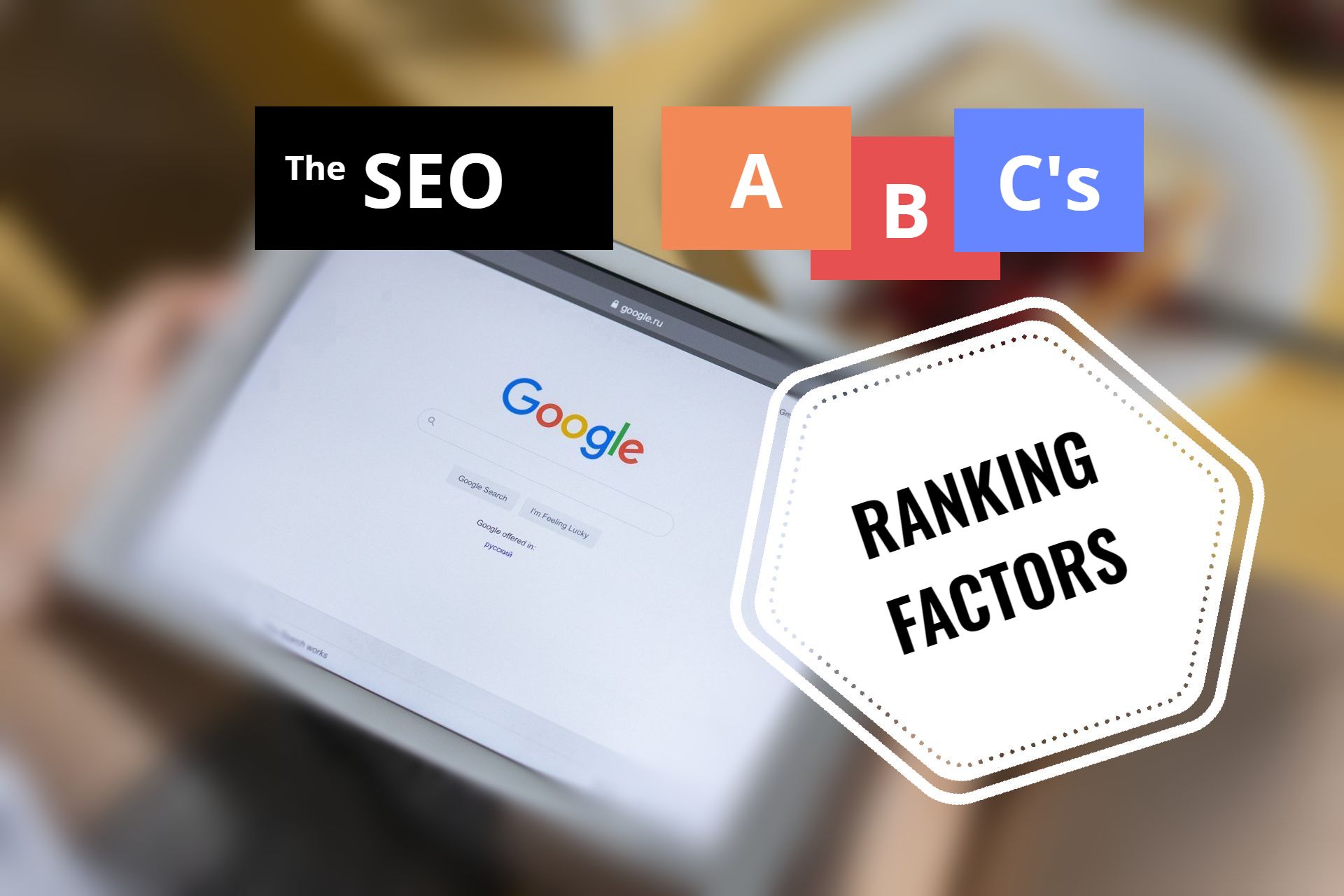
The SEO ABCs: Google Ranking Factors Explained

Like many marketers at smaller to moderately sized companies, you and your team probably juggle several tasks, not the least of which is lead generation from organic search engine traffic. But, despite a persistent and valiant effort, the endless barrage of daily deadlines and last-minute requests leaves no time to advance your team’s SEO (search engine optimization) literacy. Or efficacy. So, to help bridge the gap, your team brings in an SEO specialist, right?
Wait, no SEO specialist? Not to worry; you’re far from alone! Unlike many larger enterprises, it’s common for team members to wear multiple hats. Add to that your heavy workload and tight turnaround schedule, and there’s probably little time for anything more than a few random keyword and on-page tweaks. And since no one seems to be taking notice, you all may think, “Hey, it’ll do.” But will it?
Unfortunately, the odds won’t be favorable without a thoughtful and well-executed strategy. SEO may seem too complicated to figure out, but it isn't. And to successfully attract organic traffic, someone has to! So, why not you? With a working knowledge of just a few basic principles and practices, you could be credited for a stellar search ranking and a ton of new leads! Sound good?
Well then, let's begin your journey to conversion success with the first of our series, The ABCs of SEO, as we go over the basics of search engine functionality and the factors that influence ranking the most. Then, in subsequent posts, we’ll walk through principles and practices you can quickly master and implement on your way to SEO success!
Off we go!
The Needle in a Sea of Needles
How many Google (or other search engines) searches have you ever done? Hundreds? Thousands? And in any of those searches, did you ever ponder the reasons behind the results you were shown or the order in which they were displayed? Maybe not. But one thing was sure every time. You wanted the right results–pronto!
Well, lucky for us, our "neediness" isn't lost on Google! On the contrary, search engines strive to meet our demands with every set of results selected from what worldwidewebsize.com tells us is a network of over 4.25 billion indexed web pages! Which begs the question: How does Google do it so quickly? Well, in stark contrast to "billions," it all comes down to just three simple steps! Here they are.
The Three Stages of the Search Process
1. Discovery Phase
The name says it all. Before a search engine can analyze your web page, it must find it first (duh). To do so, it engages in the action called crawling:
Crawling is the automated process by which programs, called search engine bots or spiders, browse and index web pages online. These bots follow links from one webpage to another, collecting data and content to create a searchable index. This leads to the next phase.
2. Relevance Phase
So now that these bots have found your web page, poked around, and gathered information about it, it’s tasked with making sense of it. Taking cues from keywords and other subject matter prevalent throughout the site, they derive your page’s relevance to a particular topic through the act of indexing:
Indexing organizes and stores the information collected on your web page during the crawling phase in a structured database for quick and efficient retrieval in response to user search queries.
3. Authority Phase
Ah, this is the big one! The whole enchilada. This is where all your marketing strategies and hard work come to fruition. Now that a bot has associated your page with a topic of relevance, it's up to the search engine to decide when and how to connect it to a user’s query through what is known as ranking:
Ranking is the process through which search engines 1) assess the depth of an indexed page's relevance by satisfying a set of factors determined by each respective algorithm and then 2) compare that assessment against other (ranked) pages deemed relevant to the same query. Pages considered more relevant are displayed higher in the search engine results pages (SERPs).
Good, so far? Not so much? Let’s simplify these phases a bit further with a commonly used analogy. Because a search engine is little more than a massive digital library, we’ll go a step further and consider it a physical library. And in this library, every web page will be represented by, not surprisingly, a book.
To fully set the table, think of a search engine bot as a librarian tasked with deciding where in the library to shelve each “book” piled in a huge stack. So, just like a search engine, they take the same three steps, and it goes a bit like this:
List of Services
-
DISCOVERY PHASEItem Link List Item 1
The librarian finds the book in the stack.
-
RELEVANCE PHASEItem Link List Item 2
The librarian flips through the book to determine its characteristics. Is it fiction or non-fiction? Is it a romance or a mystery? Who’s the author?
-
AUTHORITY PHASEItem Link List Item 3
Considering the popularity of the author and their works, how frequently the book is talked about, referenced, and cited in other publications, the librarian decides whether or not to feature the book on a prominent (best-seller) shelf.
Now that you're familiar with the steps search engines take to rank a web page, you probably notice something missing. Something big. And if it's search engine ranking factors that come to mind, you’re right! So, let’s continue, shall we?
Which ranking factors matter the most?
To rank a web page, each search engine uses a complex algorithm that weighs dozens of factors. While we're not let in on all the algorithms' secrets, we can ascertain most of the determinative ranking factors. With this in mind, we’ve done some homework on the most influential of the bunch and whittled the list down to just seven:
Quality Content
Backlinks
Load Speed
On-page Optimization
User Experience (UX)
Mobile Friendly
Security
Our Seven Most Influential Ranking Factors Explained
Quality Content
There’s no single factor more crucial to SEO success than quality content! Well-written and strategically planned content fuels its discoverability and allure and helps guide user behavior toward several SEO fulfillments. Here are a few of the more consequential ones:
- Relevance to User Intent: Content quality is greatly accentuated when tailored to the intent behind these queries and effectively addresses user needs. And by doing so, it’s only natural that visitors will remain on your webpage longer. In terms of engagement metrics, this helps to elevate dwell time and reduce bounce rates, sending positive signs to search engines.
- Authority and Trustworthiness: Well-researched and accurate content helps establish your website as an authoritative industry or subject-matter source. This not only drives traffic and engagement but also attracts backlinks from other websites. When reputable sites link to your content, it affirms subject matter relevance and authority and increases the likelihood of a more favorable ranking.
- Organic CTR: Quality content is much more than the words it comprises. A vital component of a successful content strategy is the use of compelling title tags and meta descriptions that capture searchers’ attention on a SERP to enhance CTR (“Click-through Rate”). A higher CTR, coupled with favorable dwell times and bounce rates, will help propel the webpage up the ranking ladder.
High-quality content will go a long way to maximizing the relevance, engagement, authority, and trustworthiness of your web page. Ultimately, it will boost your site's overall visibility in search results, as well as user experience and alignment with a search engine's goal of delivering valuable and relevant information to users. It’s a win all around!
Backlinks
As mentioned above, backlinks (or inbound links) from other respected websites are an invaluable ranking factor because each represents a vote of confidence and subject-matter expertise. Here's why that’s so important:
- Trust and Authority: When reputable and authoritative websites link to your content, it signals to search engines like Google that it’s trustworthy, credible, and relevant. And generally, the more quality backlinks, the better!
- Contextual Relevance: Context matters big time! So, when backlinks come from websites that are not only authoritative but also in line with your intent, they reinforce the connection of your content to the expertise you wish to be known for.
While the accumulation of authoritative backlinks can require significant time, effort, and patience, it's a must-have SEO strategy component that will likely prove well worth it. By recognizing your web pages as more trustworthy, authoritative, and relevant, search engines will give more deference to your content and rank it accordingly.
Load Speed
Page load speed, to no one's surprise, is simply the time it takes for a web page to fully load in a user's browser. This metric weighs significantly with search engine algorithms in large part because of the importance placed on certain elements of user behavior. This is significant for a couple of key reasons:
- User Experience (UX): How a visitor to your site acts and reacts involves many potential sources of influence, not the least of which is load speed. Fast-loading pages allow users to navigate and interact with your content more seamlessly. This encourages your visitor to engage (versus “bouncing”), which helps to enhance “dwell time” and (hopefully) increase conversions and leads.
- Core Web Vitals: Not long ago, Google introduced Core Web Vitals as its representative set of user-centric web performance metrics. These metrics comprise three somewhat “intimidating” (yet curiously relatable) titles: Least Contentful Paint (LCP), First Input Delay (FID), and Cumulative Layout Shift (CLS). LCP measures the time it takes a webpage (i.e., images, text) to completely render, while FID tallies the time required for the webpage to be interactive or “click-ready.” Because of Google’s vested interest in the strength of these particular metrics, effective attention to them can only help your SERP ranking.
Because page load speed is so closely tied to user satisfaction and engagement, it significantly influences search engine ranking. Web pages that quickly load quality content are more likely to rank higher in search results than other like-quality pages that do not. And with the higher ranking will come more organic traffic that will lead to increased conversions.
On-Page Optimization
On-page optimization is the process of fine-tuning web pages to maximize their visibility in search engine results and motivate user behavior. This involves populating page-related elements such as title tags, meta descriptions, content, headers, and images to align with marketing goals. Here are several ways this process impacts SERP ranking:
- Relevance and Intent: Well-executed on-page SEO ensures your content aligns with users’ search intent. By incorporating relevant keywords naturally into titles, headers, and content, you signal to search engines that your page is a valuable resource for specific search queries.
- CTR (Click-Through Rate): Strategically worded title tags and meta descriptions make your search results stand out to users, increasing the likelihood of more traffic to your website. A higher CTR not only increases organic traffic but can also positively impact your rankings, as a healthy CTR is seen as an indicator of user satisfaction by search engines.
- Content Quality: On-page optimization works hand in hand with textual messaging as part of the content creation process. When informative content is thoughtfully organized and well-structured, it tends to attract more engagement, shares, and natural backlinks, each of which search engines value and prioritize.
- User Experience (UX): On-page optimization supports a positive user experience. Clear headings, organized content, fast page loading, and mobile-friendliness help improve user satisfaction, reduce bounce rates, and lead to better rankings.
- Crawling and Indexing: Effective attention to descriptive URLs, header tags, and image alt text helps search engine bots better understand the content and structure of your pages. This, in turn, lends to greater crawling and indexing efficiency and assurance that your content is properly categorized and ranked.
- Structured Data (Schema Markup): Implementing structured data, such as schema markup, provides additional context to search engines. This can facilitate the selection of targeted web page elements as "rich snippets," which can greatly enhance the visibility of your content in search results and improve click-through rates.
- Local SEO: For brick-and-mortar businesses that rely significantly on foot traffic, on-page optimization enables preferential search engine listings for local searches. This involves accurate NAP (Name, Address, Phone Number) information, location-specific keywords, and schema markup for local businesses.
In summary, on-page SEO drives ranking by directly fortifying a web page's relevance, visibility, and user experience. It helps search engines understand your content and makes it more appealing to users, thus increasing organic traffic and conversions.
User Experience (UX)
UX, or on-page experience, refers to the quantified satisfaction a user derives from interacting with a website or digital asset. It encompasses factors such as ease of use, accessibility, page loading speed, mobile-friendliness, navigability, and content relevance. Here's how UX influences search engine ranking:
- User Satisfaction: Google's primary goal is to provide users with the best possible search experience. Webpages that offer a positive on-page experience increase user satisfaction and engagement.
- Bounce Rates: When webpages load quickly, have stable layouts, and respond well to user interactions, users are less likely to bounce (leave the page immediately). Lower bounce rates are a positive signal to search engines.
- Dwell Time: Users tend to stay longer on web pages that offer a smooth and pleasant on-page experience. Longer dwell times indicate that users find the content valuable and engaging.
- User-Centric Focus: On-page experience metrics, such as Largest Contentful Paint (LCP), First Input Delay (FID), and Cumulative Layout Shift (CLS), predictively rate the level of positivity (or negativity) with which users perceive a webpage's loading, interactivity, and visual stability. As mentioned prior, Google prioritizes user-centric factors in rankings.
Because on-page experience directly influences user engagement, it's essential to ranking. Prioritizing a positive on-page experience will not only help improve rankings but also ensure that users more intently interact with your website, ultimately leading to increased conversions, as well as brand trust and popularity.
Mobile-Friendly
Mobile-friendly design (or responsive web design) refers to a website's ability to load and function optimally and seamlessly on smartphones and tablets. It involves behind-the-scenes instructions (e.g., HTML code) that enable website elements to recognize a device’s screen dimensions and responsively render in a manner and format that exhibits fast loading times, intuitive navigation, and orderly content layout. Here's why it's essential to ranking:
- User Behavior: Most web traffic comes from mobile devices, and search engines know it! As such, they are programmed to actively encourage and reward this popular practice by providing users with the best possible mobile experience. Websites that fail to meet the mobile-friendly standard will often be passed over or de-prioritized during mobile searches in favor of those that do.
- Mobile-First Indexing: Some time ago, Google (and other search engines) adopted a mobile-first indexing approach. As such, search engines prioritize your website's mobile version (if you have one) for crawling and indexing. If your site isn't mobile-friendly, its ranking could suffer the consequences.
- User Experience (UX): Because websites with responsive design adapt their pages to screen size, they enable continuity of load response (load speed), accessibility, and readability no matter the device, and that helps to ensure the seamlessly strong user experience that search engine algorithms love.
- Bounce Rates: Today’s users expect a mobile-friendly experience, period. When websites don't meet these expectations, visitors notice, which all too often means a quick escape and a potential “ding” to ranking. But when users can navigate and interact smoothly, they’re likelier to stick around, explore, and engage. And that sends good vibes to search engines!
Overall, mobile friendliness reflects the importance of delivering a positive user experience to mobile users. With the ever-increasing prominence of mobile device usage, ensuring that your website is mobile-friendly is just as critical to a successful SEO strategy as it is to attracting and retaining traffic to your site.
Security (HTTPS)
HTTPS (Hypertext Transfer Protocol Secure) is a secure version of an otherwise standard HTTP website that encrypts data transferred between a user's browser and a web server to help protect it from eavesdropping and cyberattacks during transmission. Given the choice between insecurity or security, search engines will take the latter any day, and here are some essential reasons why:
- Trust: Users are more at ease accessing secure websites. When users see the padlock icon and "Secure" in their browser's address bar, they are more likely to trust the website and feel confident sharing their personal information, such as email addresses or payment details. Conversely, browsers will generally “flag” non-secure websites with warnings, potentially deterring users from accessing those sites. This can lead to a decline in organic CTR and negatively affect SEO.
- User Experience (UX): Secure websites tend to load faster because most browsers prioritize secure connections. Faster-loading pages enhance UX and enable lower bounce rates and increased dwell times, which are positive signals for search engine rankings.
HTTPS protection, as with mobile friendliness, is almost universally expected. Without it, the loss of user trust and data protection go hand-in-hand, along with the compromise of user experience. This is why secure websites are favored by search engines and a quick and easy way to help ensure your site’s ranking success.
Conclusion
SEO isn’t an easy discipline to navigate. Nothing worthwhile ever is. But it’s far from impossible. Like most things in life, you start at the beginning with a first step. So, to best understand all the ins and outs of optimizing your company’s website, it makes sense first to learn how search engines do what they do and identify the influences that drive their behavior. By exploring the role of several determining factors, such as content quality, backlinks, UX, and security, you can build a bridge to the skills and techniques required to navigate the ever-evolving landscape of SEO effectively. From there, you'll be on your way to driving SERP positioning, organic traffic, and overall marketing success to new levels!
So, stay tuned for more in-depth insights in the next of our SEO series posts. Till then, happy marketing!
Like what you read? We'd love for you to share it!



